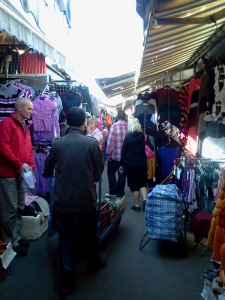
From a window of one of the many warehouses along Baross utca, facing an overgrown area containing a few abandoned buildings
Alone, I rode the accordion bus no. 9 over its much trodden path to that place where Magyar mixes with the Orient. Here, the inhabitants have worn out their welcomes, the filled warehouses that hold them seeming to sigh out their bricks and shedding their once lustrous skins from years of heavy use and neglect. The eighth kerület, or district, of Budapest is nowhere near the largest of the city’s twenty-three (geographically, the seventeenth holds this title, while the seventh claims the highest population density) but is a contender for one of the most varied in landscape and ethnic backgrounds.
Seen from a lofty position of a window-side seat along this particular stretch of Baross utca is a mess of impromptu Asian outdoor marketplaces, looking like misplaced tectonic tin puzzle pieces that have been drunkenly jammed in to fit by an impatient god. Beneath these roofs, partially limbed manikins look like veteran security guards, eyeing the crowds for potential pilferers and shoplifters.
Like their stony-faced plastic counterparts, many of the vendors here sit eerily still, crouched, staring off into the distance, cupping their small white bowls of steaming sticky rice. Some of the more prescient sellers are listening to old radios emitting static and wailing Chinese violins. Their Hungarian and Romanian neighbors are tuned into American pop stations, creating an interesting clash of old world and new. Funneling down narrow paths past the ubiquitous makeshift shops, I took out my tablet to take a few shots, drawing heads to turn in my direction all at once. “Elado? Elado?” they called out excitedly, following close behind and abandoning their lunchtime kebabs, some reaching out to get a feel of the device. While a little curious to see just how much my used Samsung Xoom would go for in the black market, I decided to make my exit before it was pried from my hands for free.
Opposite the slapdash shantytown sat spacious warehouses stuffed with shiny, tightly sealed candies, dried mushrooms, and seaweeds imported from the East. Here, too, the inhabitants fixed their expressionless gazes into the distance, some sitting on cardboard boxes and mumbling to themselves, a desolate scene out of Beckett’s Waiting for Godot. Again, the endless rows and passages seemed to repeat over and over again like the background of a primitively drawn cartoon, so I made my way around back over obliterated cobblestone and past ominous factories amidst heaps of rusted beams and shards of window glass.
A church, still in use and very much having the grandeur that such a building should have in Europe, stood just down the street, squashed between blocky, yellowing tenements that had at first hidden it from my view. A little more carefully this time, I took out my tablet to take a quick snapshot, when a voice startled me from behind. “Do you need directions?” he asked politely. “Are you lost?” It didn’t occur to me just then how perfect his English was, and the fact that he was speaking English.
After explaining who I was, that being a szabadúszó újságíró, or freelance journalist, he introduced himself, with the slightest of Scandinavian accents, as Pastor Borgyucca. A Finnish native, he had joined the church as pastor on its opening in 1999. Pointing to the scrapyard I had just passed, he explained that the area was once an important hub for the Royal Hungarian State Railway. With its demise came massive unemployment in the district, which has seen its fair share of changes over the last few years. In fact, the very church before us, he explained, had a chameleon life of its own up until recent years, having been a site for the castle-like water tower that still juts up stalwartly from behind as well as a notorious club for rock and roll and rampant drug use.
Now, it peers peacefully over the other crumbling buildings of this slowly fading yet distinctly diverse part of the eighth district, a few homeless people digging hopefully through its oversized, rectangular dumpsters in the courtyard or otherwise simply sitting, eyes forward, waiting for something to happen.



